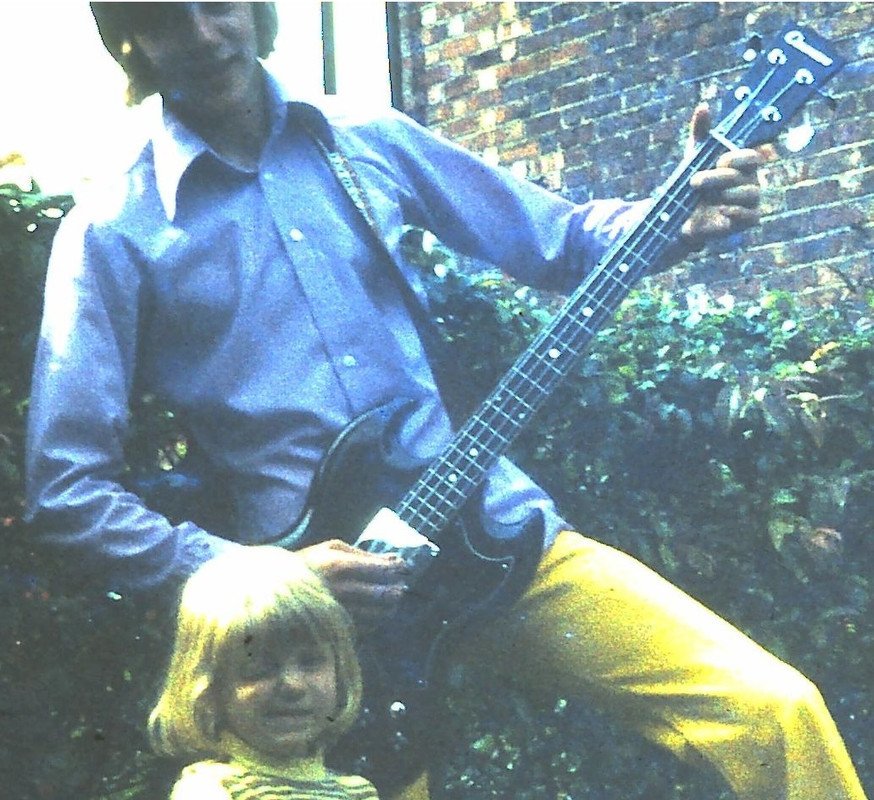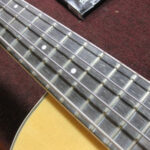For many bass players, the quest for the perfect instrument is a lifelong journey, often filled with twists, turns, and rediscovering old flames. After 47 years away from Gibson basses, I recently found myself drawn back to the iconic brand, specifically to the Gibson Sg Bass Guitar. My first Gibson was an EB2 semi-hollow, a bass I remember fondly for its ease of play and warm tone, although it lacked the punch needed for the rock band I was in back then. Fast forward several decades, and the desire for that classic Gibson feel returned, leading me to trade for an SG bass – a decision that has rekindled my appreciation for Gibson’s unique approach to bass design.
From EB2 Memories to SG Bass Reality
My early bass experiences were shaped by instruments that, while not top-of-the-line, ignited a passion for low-end frequencies. Before the EB2, a Columbus EB3 copy (pictured below in a snapshot from 50 years ago) served as my entry point into the world of Gibson-style basses. Like many young players, my influences were diverse, ranging from Paul McCartney to Jimmy Lea of Slade. Lea’s basslines, particularly on Slade’s version of “Move Over,” were formative, requiring hours of practice to decipher.
 Young bass player with a Columbus EB3 copy bass guitar, reminiscent of early Gibson EB basses.
Young bass player with a Columbus EB3 copy bass guitar, reminiscent of early Gibson EB basses.
Decades later, the opportunity arose to acquire a Gibson SG bass. A trade was arranged with Dave808 from a guitar forum, leading to a pleasant drive to Birmingham. Dave proved to be a great guy, and after a thorough exchange and inspection of our respective basses, the SG bass was mine. One of my biggest concerns was neck dive, a common issue with SG basses. To my relief, this particular Gibson SG bass guitar was well-balanced and exhibited no neck dive – a crucial factor for comfortable playing.
The Gibson SG Bass: Design and Features That Stand Out
The Gibson SG bass, while sharing the SG body shape with its guitar counterpart, holds its own distinct identity. Though Gibson inexplicably dropped the EB3 designation, the lineage is clear. The mahogany body of the Gibson SG bass resonates with warmth and sustain, a hallmark of Gibson instruments. This particular model features an upgraded Hipshot Supertone bridge, a significant improvement over the notoriously cumbersome original Gibson 3-point bridge, which thankfully was included in the trade.
 Close-up of a Gibson SG bass guitar body, highlighting the mahogany wood and SG shape.
Close-up of a Gibson SG bass guitar body, highlighting the mahogany wood and SG shape.
The pickup configuration on the Gibson SG bass is another key element of its sonic character. It boasts a powerful neck humbucker and a bridge mini-humbucker, controlled by two volume knobs and a master tone. The black tophat knobs with silver inserts add a touch of vintage style. The mahogany neck, topped with a rosewood fingerboard and corian nut, offers a comfortable 30.5-inch short scale and 20 frets, making it incredibly easy to navigate. This 2011 model, with its satin nitrocellulose finish, has aged gracefully, developing a subtle gloss through years of play.
 Gibson SG bass guitar headstock with tuning pegs, showcasing the classic Gibson design.
Gibson SG bass guitar headstock with tuning pegs, showcasing the classic Gibson design.
Last year, I had briefly encountered a brand new Gibson SG Standard bass with a gloss finish and block markers. While visually stunning and possessing a rich tone, its severe neck dive was a deal-breaker. My preferred playing position is more diagonal, and the new SG Standard simply refused to stay put. While solutions exist for neck dive, I wasn’t keen on tackling the issue with a brand new instrument. Dave808’s assurance that this traded Gibson SG bass was free from neck dive, further aided by his use of a wide suede strap, was a major selling point. While the gloss finish of the Standard model is undeniably attractive, the playability and balance of this satin-finished Gibson SG bass trumped aesthetics. The aged satin finish, now subtly glossed from use, adds a unique character, particularly on the smooth neck and fretboard. The low and consistent action is perfectly set up for my playing style.
Tone and Playability: A Vintage Heart with Modern Versatility
The Gibson SG bass guitar delivered a pleasant surprise when plugged in. The pickups offer a versatile tonal palette. While capable of edgy, growling tones when pushed, they retain a core vintage warmth and body, with enough focus and bite to cut through a mix. Like many dual-pickup basses with individual volume controls, I found the sweet spot by running one pickup at full volume and the other slightly backed off, adjusting for deeper tones or more aggressive bite. The bass arrived strung with LaBella flatwound strings, a favorite for many, but I plan to switch to Elixirs to suit my personal preference.
 Full view of a Gibson SG bass guitar, demonstrating its satin nitrocellulose finish and overall design.
Full view of a Gibson SG bass guitar, demonstrating its satin nitrocellulose finish and overall design.
Overall, this Gibson SG bass guitar is a classic instrument with undeniable vintage appeal in looks, sound, and feel. While distinct from Fender basses and many modern designs, it proves to be highly usable in a band context, especially for my 60s band project. My Guild Starfire bass will now take on duties in my R&B and Soul band, making the Gibson SG bass a perfect fit for vintage rock and roll. Rediscovering the Gibson SG bass has been a rewarding journey back to Gibson, reminding me why these basses hold such a special place in music history.

